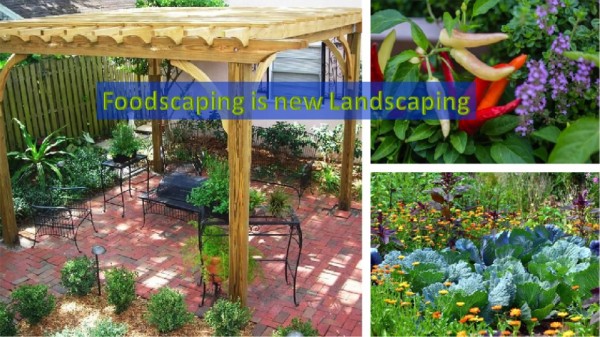
Foodscaping is new landscaping
Until recently landscaping with varieties of decorative plants, green lawn is a must have feature for new homes and office buildings in many countries. Reason to add this feature is, it adds beauty and value for the concrete building. For landscaping mostly flowering plants, grasses, herbs, gymnosperms are used. Some of these plants attracts bees and other animals. Some are annuals that need every year planting. Instead of just focusing on annual plants that need replacement, a new design that helps to grow our own food in the landscape is an idea that is attracting millennials. It gives fresh produce, helps saving and moreover gives satisfaction of growing our own food. This new way of garden designing is called Foodscaping or edible landscaping.
According to gardening author, speaker Brie Arthur – Foodscaping is planting edible plants in landscape or in the available space in existing landscaping. It is mix of ornamentals and edibles in same planting area.
Foodscaping involves designing gardens with edible plants It will help to create an ecological living environment that allows consumers to produce fresh organic and inexpensive food. Edible plants means – fruit trees, shrubs, medicinal herbs, vegetables etc. Selected plants should have ability to produce fruits or vegetables in abundance with little maintenance like permaculture.
What we can grow in foodscaping?
Vegetable plants does not attract many people. People grow them in backyard or in a corner. But, many vegetable plants are very attractive, and we must able to see the beauty in these plants. Edible plants such as strawberries, colorful varieties of peppers, scarlet runner beans are very attractive plants. Mint, tulsi, lavender, lemongrass, rosemary, chamomile, sage, beebalm, scented leaf geranium etc give fragrant flowers and leaves. They are either perennials or annual plants. One can grow marigold, dianthus, pansies with most vegetables.
Adding edible plants in the border of already existing garden is easy. This way non-productive borders will convert to garden that gives benefit with beauty.
Brie Arthur in her book The Foodscape Revolution says ‘you don’t have to grow everything you eat but you can grow somethings. She also suggests starting with garlic for those who don’t know gardening. Growing garlic and other herbs in the edge detours pets and pests and keeps plants safe. Some plants can be grown along edges of beds, paths and borders.
To start foodscaping Arthur gives tips:
- Look at space where you want to grow your food. Food crops need more Sun.
- Depending on availability of space you can decide where and how much space you are going to use for foodscaping – or plant between shrubs or edge or near fence.
- Decide what really you want to grow. You must select those vegetables that you eat on daily basis. Beginners should grow those plants that are less challenging and after gaining confidence, should move to other vegetables.
- Get organic material for foodscaping. Understand what type of soil is good for vegetables. Buy nutrients if needed.
- Create edible meadow with plants like corn, sorghum and sunflower
- On top of build up soil one can grow tomatoes, peppers, eggplants, beans etc.
- Grow groundcover of strawberries around the existing flowering plants like hydrangea, azaleas
- Grow fruit trees that attracts birds and gives plenty of fruits
- Use squash, sweet potatoes, pumpkins that spread with vines as groundcovers.
Foodscaping is new trend with millennials. It is gaining more attention for all right reasons. Grow plants in a way that introduces more biological diversity to help nature and soil and enjoy watching your plants growing.
References:
https://gardentherapy.ca
Author: HealthyLife | Posted on: February 22, 2019
« Edible blob, Water bottle that you can eat Tap water around the world contaminated with plastic fibers »






















Write a comment